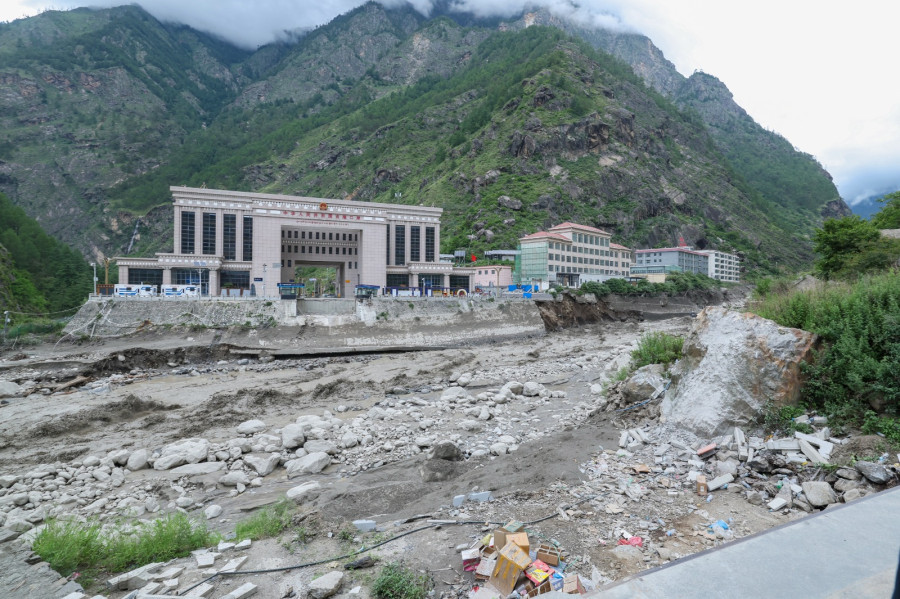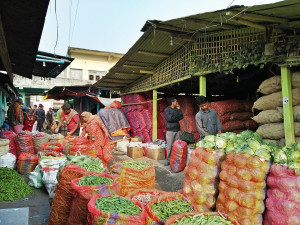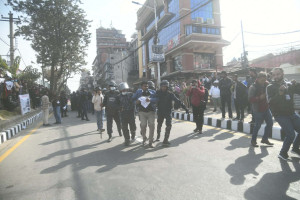Editorial
Make haste
It’s in Nepal’s larger interest to open the obstructed border point at Rasuwagadhi at the earliest.
Tuesday’s floods have once more spotlighted the vulnerability of trading through Nepal’s northern border with China. It has wreaked havoc in the Rasuwagadhi border area, sweeping away the key bridge connecting the two countries, damaging important infrastructures such as the dry port, yards of customs office and road sections. Goods being transported have been abruptly stopped along the border areas on both sides. The supply chains between the two countries could be disrupted for weeks—maybe even months. With the disruption in Rasuwagadhi, which is being developed as the major trade link between the two countries, the prices of goods could rocket in Nepal, right before the start of major festivals.
Though Nepal and China have taken several initiatives to expand bilateral trade, businesses and other development activities in recent years, experience suggests any disruption caused by a natural disaster or other factors takes an unnaturally long time to fix. For instance, it took years for Tatopani border point to come into operation after the 2015 earthquakes destroyed roads and other infrastructure at the border point. Then, as the Chinese side tightened the movement of people and goods for long during the Covid-19 pandemic, Nepali markets that had become increasingly dependent on Chinese supply incurred big losses. Frustrated by the long disruption with China, people used to describe it as “a blockade-like situation”. Though the Tatopani customs resumed operation after around eight years, trade through the route is still patchy.
It has become essential for Nepal and China to develop at least a couple of all-weather trade routes that operate round the year. Nepal has long failed to upgrade the Araniko Highway after it was built in the early 1960s with Chinese support. The work on the much talked project of upgrading the Rasuwagadhi-Kerung trading route is progressing at snail’s pace. Nepali officials project several border points as possible trade routes and talk of bringing multiple trade routes in operation, but there is little progress on the ground. Nepali side opens certain border points with much fanfare, but hardly any of them stay open for more than a few months due to lack of reliable road connections and infrastructure at the custom points. For instance, Home Minister Ramesh Lekhak inaugurated the immigration office at Korala in Upper Mustang’s Lomanthang on October 30 last year. But it was closed immediately after the immigration officials left the place, citing lack of accommodation to protect them from the harsh weather at an altitude of 4,650 metres above sea level.
Like the 2015 earthquakes and other natural disasters in the bordering mountain districts, Tuesday’s devastation again emphasises the need to work seriously to develop disaster-prone infrastructure across the Himalayas. A meeting of the National Council of Disaster Risk Reduction and Management chaired by the prime minister on Tuesday has decided to immediately coordinate with China on rebuilding the Nepal-China Friendship Bridge and other key road links. Doing so is vital in view of the upcoming major festivals such as Teej, Dashain, Tihar and Chhath. It is in Nepal’s interest to ensure that Nepal’s key road links to China, one of its only two neighbours, are operational around the year. This is not just about securing key trade routes with the north. For a landlocked country, it is also about developing and keeping open alternate means of trade and transit.




 10.12°C Kathmandu
10.12°C Kathmandu












%20(1).jpg&w=300&height=200)

